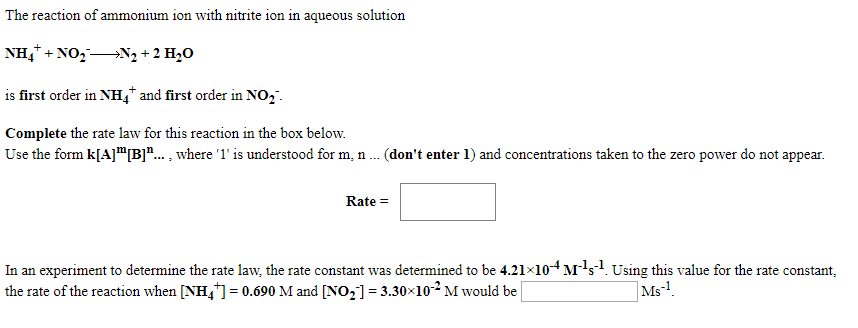1a) The reaction of nitrogen dioxide with fluorine 2 NO2 + F22 NO2F is first order in NO2 and second order overall. Complete the rate law for this reaction in the box below. Use the form k[A]m[B]n... , where '1' is understood for m, n ... (don't enter 1) and concentrations taken to the zero power do not appear. Rate =
1b) The reaction for the formation of phosgene from carbon monoxide and chlorine CO + Cl2COCl2 is first order in CO and first order in Cl2. Complete the rate law for this reaction in the box below. Use the form k[A]m[B]n... , where '1' is understood for m, n ... (don't enter 1) and concentrations taken to the zero power do not appear. Rate = In an experiment to determine the rate law, the rate constant was determined to be 1.64Ã10-28 M-1s-1. Using this value for the rate constant, the rate of the reaction when [CO] = 0.673 M and [Cl2] = 0.354 M would be
1c) The gas phase reaction of hydrogen with iodine H2 + I22 HI is first order in H2 and first order in I2. Complete the rate law for this reaction in the box below. Use the form k[A]m[B]n... , where '1' is understood for m, n ... (don't enter 1) and concentrations taken to the zero power do not appear. Rate = In an experiment to determine the rate law, the rate of the reaction was determined to be 1.11Ã10-21 Ms-1 when [H2] = 2.88Ã10-2 M and [I2] = 1.67Ã10-2 M. From this experiment, the rate constant is
1a) The reaction of nitrogen dioxide with fluorine 2 NO2 + F22 NO2F is first order in NO2 and second order overall. Complete the rate law for this reaction in the box below. Use the form k[A]m[B]n... , where '1' is understood for m, n ... (don't enter 1) and concentrations taken to the zero power do not appear. Rate =
1b) The reaction for the formation of phosgene from carbon monoxide and chlorine CO + Cl2COCl2 is first order in CO and first order in Cl2. Complete the rate law for this reaction in the box below. Use the form k[A]m[B]n... , where '1' is understood for m, n ... (don't enter 1) and concentrations taken to the zero power do not appear. Rate = In an experiment to determine the rate law, the rate constant was determined to be 1.64Ã10-28 M-1s-1. Using this value for the rate constant, the rate of the reaction when [CO] = 0.673 M and [Cl2] = 0.354 M would be
1c) The gas phase reaction of hydrogen with iodine H2 + I22 HI is first order in H2 and first order in I2. Complete the rate law for this reaction in the box below. Use the form k[A]m[B]n... , where '1' is understood for m, n ... (don't enter 1) and concentrations taken to the zero power do not appear. Rate = In an experiment to determine the rate law, the rate of the reaction was determined to be 1.11Ã10-21 Ms-1 when [H2] = 2.88Ã10-2 M and [I2] = 1.67Ã10-2 M. From this experiment, the rate constant is


